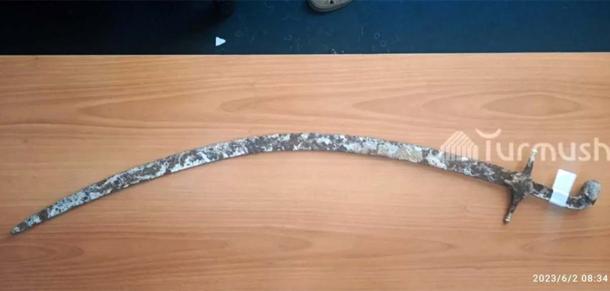Unearthed Treasure: Saber Sword Found in Kyrgyzstan is a Medieval Marvel!
Amidst the serene village of Amanbaev in the Talas Region of Kyrgyzstan, a momentous discovery has come to light which has been dubbed the Kyrgyzstan saber. This ancient military saber sword boasts a weighty frame, a lengthy cutting edge and a gracefully curved blade, showcasing the pinnacle of medieval artistry. Remarkably rare in Central Asia, this exquisite Kyrgyzstan saber was discovered in exceptional condition, serving as a vivid testament to the extraordinary craftsmanship wielded by medieval blacksmiths.
The names behind this discovery are a trio of dedicated brothers—Chyngyz, Abdylda and Kubat Muratbekov, along with their compatriot Nurdin Jumanaliev. The find was announced by Siyatbek Ibraliev, a researcher at the Kyrgyz national complex Manas Ordo, a tourist destination and cultural site in Talas dedicated to the legendary Kyrgyz hero, Manas, who is a central figure in Kyrgyz epic literature.
“The brothers, with a fervent passion for archaeology, have been ceaselessly committed to unearthing hidden treasures from the past. In a span of just one year, they have generously added around 250 valuable historical artifacts to the museum’s collection, an endeavor deserving of admiration,” stated Siyatbek Ibraliev in Turmush, who reported the find to be from the 4th of June, 2023.

The ancient Kyrgyzstan saber, discovered in Amanbaev. (Siyatbek Ibraliev / Turmush)
A Scimitar-Like Saber: Kyrgyzstan Saber Was a Lethal Weapon
The Kyrgyzstan saber consists of a pommel, a hilt, an impressive blade and a steadfast guard. Its origins trace back to the 12th century in Iran, from which it ventured to distant lands, stretching its influence from Morocco to Pakistan. The gentle curvature of this weapon’s blade suggests a possible connection to the Muslim realm, akin to the famed shamshir sabers of the Indo-Iranian expanse.
The total length of the recently discovered Kyrgyzstan saber extends to 90 centimeters (approximately 35.4 inches), while the tip length delicately spans 3.5 centimeters (approximately 1.4 inches). The hilt boasts a length of 10.2 centimeters (approximately 4 inches), and the handguard, a sentinel of defense, measures 12 centimeters (approximately 4.7 inches) in length. The blade, a focal point of both form and function, stretches to 77 centimeters (approximately 30.3 inches) in length, with a width of 2.5 centimeters (approximately 1 inch).
Recognized as a scimitar by European sensibilities, the shamshir saber claims its legacy as the definitive longsword wielded by the equestrian champions of Persia (Iran), Arabia and Moghul India. Renowned for its sharpness and lethality, its curvature helped those warriors with the agility to excel at slashing attacks, whilst spinning.
It is a marvel of science because this curvature does not allow the full weight of the saber to be felt when in full flurry. It is particularly useful for slicing attacks in rapid motions, with a high success rate and precision, reported Arkeonews.

The Kyrgyzstan saber was discovered amongst a treasure trove which included a smelting vessel, coins, a dagger amongst other ancient artifacts. (Siyatbek Ibraliev / Turmush)
More Play with Metal: A Vessel, Numismatics and a Dagger
The findings also include a vessel, a mere 5 centimeters in diameter, designed for the purpose of smelting metal, with a thin neck for pouring liquid. These same cups were used in the Middle Ages to carry coins of gold, silver and copper.
An accompanying coin with intricate Arabic inscriptions on both sides was also found. This currency, marked by its association with the Karakhanid state during the 11th century, once circulated within the lands of Kyrgyzstan. Sıyatbek Ibraliyev further elaborated that the presence of both metal-melting tools and minted coins painted a vivid portrait of workshops that once thrived within the vicinity.
An important distinction is that the rulers of that period made dirhams (and not coins) from gold, silver, and copper, weighing anywhere between 2.5 and 3.5 grams. What is particularly interesting and relevant from this privy into numismatics is how frequently borders of the Arabic states changed, the extent of these borders, and the genealogy of the Karakhnid period (like other empires, the rulers were fond of leaving grand insignia on the dirhams).
These dirhams also show us the extent of economic activity and inflation. For example, in 1035, one dirham helped with the purchase of 8 kilos of weight and 12 kilos of barley! In 1046, 160 kilograms of grapes could be bought with one dirham, while a regular agricultural horse cost 20 dirhams (cavalry horses cost somewhere around 300 dirhams).
Finally, a rusted dagger, pointed on both sides with a length of 24.8 centimeters, and a thickness of 4.3 centimeters at its widest part, was also found. Where the handle should have been, it was 5 centimeters in thickness. To date, the Manas Ordo complex has received 39 finds, and these are some of the most exciting of those!
Related Post
A shocking documentary proves that mermaids do exist
SHOCKING Revelation: Thuya, Mother of Queen Tiye, Was the Grandmother of Akhenaten and Tutankhamun—What Ancient Egyptian Secrets Did She Leave Behind?
Breaking News: Astonishing Discoveries at Karahan Tepe Confirm an Extraterrestrial Civilization is Hiding on Earth, and NO ONE Knows!
Breaking News: Researchers FINALLY Discover U.S. Navy Flight 19 After 75 Years Lost in the Bermuda Triangle!
NASA’s Secret Investigation: Uncovering the Astonishing Mystery of the UFO Crash on the Mountain!
Explosive UFO Docs LEAKED: Startling Proof That Aliens Ruled Ancient Egypt!